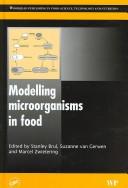| Listing 1 - 3 of 3 |
Sort by
|
Book
ISBN: 9780839149149 Year: 2007 Publisher: Boca Raton CRC Press
Abstract | Keywords | Export | Availability | Bookmark
 Loading...
Loading...Choose an application
- Reference Manager
- EndNote
- RefWorks (Direct export to RefWorks)
Predicting the growth and behaviour of microorganisms in food has long been an aim in food microbiology research. In recent years, microbial models have evolved to become more exact and the discipline of quantitative microbial ecology has gained increasing importance for food safety management, particularly as minimal processing techniques have become more widely used. These processing methods operate closer to microbial death, survival and growth boundaries and therefore require even more precise models. Written by a team of leading experts in the field, Modelling microorganims in food assesses the latest developments and provides an outlook for the future of microbial modelling. Part one discusses general issues involved in building models of microbial growth and inactivation in foods, with chapters on the historical background of the field, experimental design, data processing and model fitting, the problem of uncertainty and variability in models and modelling lag-time. Further chapters review the use of quantitative microbiology tools in predictive microbiology and the use of predictive microbiology in risk assessment. The second part of the book focuses on new approaches in specific areas of microbial modelling, with chapters discussing the implications of microbial variability in predictive modelling and the importance of taking into account microbial interactions in foods. Predicting microbial inactivation under high pressure and the use of mechanistic models are also covered. The final chapters outline the possibility of incorporating systems biology approaches into food microbiology.
Nutritionary hygiene. Diet --- voedselmicrobiologie --- probiotics --- micro-organismen

ISBN: 1845690060 9786611442125 1281442127 1845692942 9781845692940 9780849391491 0849391490 9781845690069 Year: 2007 Publisher: Cambridge : Woodhead Publishing Limited,
Abstract | Keywords | Export | Availability | Bookmark
 Loading...
Loading...Choose an application
- Reference Manager
- EndNote
- RefWorks (Direct export to RefWorks)
Predicting the growth and behaviour of microorganisms in food has long been an aim in food microbiology research. In recent years, microbial models have evolved to become more exact and the discipline of quantitative microbial ecology has gained increasing importance for food safety management, particularly as minimal processing techniques have become more widely used. These processing methods operate closer to microbial death, survival and growth boundaries and therefore require even more precise models. Written by a team of leading experts in the field, Modelling microorganims in food assess
Food --- Microbiology. --- Sanitary microbiology --- Bacteriology --- Food contamination. --- Food microbiology --- Forecasting --- Risk assessment
Digital
ISBN: 1845692942 9781845692940 Year: 2007 Publisher: Cambridge, England Woodhead Pub
Abstract | Keywords | Export | Availability | Bookmark
 Loading...
Loading...Choose an application
- Reference Manager
- EndNote
- RefWorks (Direct export to RefWorks)
Predicting the growth and behaviour of microorganisms in food has long been an aim in food microbiology research. In recent years, microbial models have evolved to become more exact and the discipline of quantitative microbial ecology has gained increasing importance for food safety management, particularly as minimal processing techniques have become more widely used. These processing methods operate closer to microbial death, survival and growth boundaries and therefore require even more precise models. Written by a team of leading experts in the field, Modelling microorganims in food assesses the latest developments and provides an outlook for the future of microbial modelling. Part one discusses general issues involved in building models of microbial growth and inactivation in foods, with chapters on the historical background of the field, experimental design, data processing and model fitting, the problem of uncertainty and variability in models and modelling lag-time. Further chapters review the use of quantitative microbiology tools in predictive microbiology and the use of predictive microbiology in risk assessment. The second part of the book focuses on new approaches in specific areas of microbial modelling, with chapters discussing the implications of microbial variability in predictive modelling and the importance of taking into account microbial interactions in foods. Predicting microbial inactivation under high pressure and the use of mechanistic models are also covered. The final chapters outline the possibility of incorporating systems biology approaches into food microbiology. Modelling microorganisms in food is a standard reference for all those in the field of food microbiology. Assesses the latest developments in microbial modellingDiscusses the issues involved in building models of microbial growthChapters review the use of quantitative microbiology tools in predictive microbiology.
| Listing 1 - 3 of 3 |
Sort by
|

 Search
Search Feedback
Feedback About
About Help
Help News
News